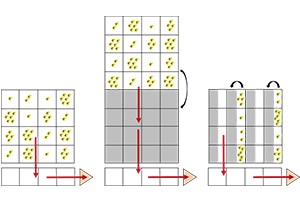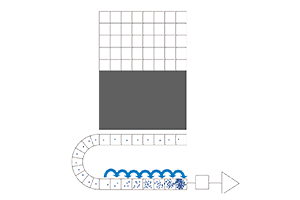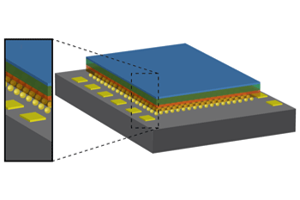ICCD Sensors
Intensified CCD (ICCD) cameras use a CCD sensor combined with an intensifier. They are optimal for low-light or single photon applications due to the electron multiplying component of the intensifier. They are also ideal for applications which require less than nanosecond exposure time, such as laser induced breakdown spectroscopy or fluorescent lifetime imaging microscopy due to the intensifier’s ability to rapidly close the shutter while still converting any photons detected into photoelectrons.
Intensifiers are comprised of three components; a photocathode, a microchannel plate (MCP), and a phosphor screen deposited onto a fiber optic (Figure 1). The photocathode is situated behind the quartz window and converts incident photons into photoelectrons. The number of photons that are converted to photoelectrons is determined by the quantum efficiency of the camera and the wavelength of light.

Photons are detected by the photocathode and converted into electrons. These electrons are then accelerated to the MCP by a controlled voltage increase. The MCP converts each photoelectron into a cloud of electrons which then travel to the phosphor screen into the fiber optic.
The photoelectron cloud is initiated by a high voltage which accelerates incoming electrons into the walls of multiple small channels within the MCP. This causes a cascade of secondary electron emissions producing a cloud of electrons. As this process is related to the voltage over the MCP, it is determined by the gain of the camera.
The electron cloud created by the MCP hits the phosphor fiber optic and any electrons are absorbed. These electrons are then converted into visible light within the fiber optic and detected by the CCD. As the incident photoelectrons are multiplied within the MCP, the ICCD detector is highly sensitive, with single photon detection capability.
ICCD detectors have ultra-high shutter speeds due to the controlled voltage across the intensifier. If the controlled voltage is reversed, the photoelectrons accelerate towards the photocathode rather than the MCP. This prevents any photons from travelling through the intensifier to the CCD. This process is referred to as gating.
emICCD sensors
emICCDs combine the advantages of both ICCD and EMCCD technology. As emICCDs are able to amplify signal through two separate processes (intensifier and electron multiplier), they have the ability to apply both gain mechanisms simultaneously. Therefore, maximum gain is achieved allowing high sensitivity for low light and single photon imaging.
This combination of gain also eliminates non-linearities that are common in ICCDs. The non-linearity of ICCDs arises due to saturation of the MCP channels. This can influence the dynamic range of the ICCD and potentially alter quantitative measurement. This saturation is linked to high gain, so low gain must be used for a more linear response. As emICCD has two processes which take advantage of gain, the gain on the ICCD components can be reduced while the gain on the EMCCD components can be increased, compensating for any lost amplification from the MCP.
As emICCD sensors still have gating incorporated, they are able to operate at high speeds while still maintaining an increase in sensitivity, linearity and dynamic range. This makes them optimal for capturing dynamic processes.
Summary
ICCD sensors are able to multiply signal by increasing the number of electrons that are generated within the intensifier. Through a cascade processes, the electrons that pass through the MCP are converted into electron clouds before being converted into visible light by the phosphor screen and transferred to the CCD by a fiber optic. This allows for low light signal detection and high sensitivity.
Due to the ultra-high shutter speeds, ICCD sensors are able to image at sub nanosecond exposure time. As the gating mechanism is controlled by the voltage across the intensifier, it can be readily controlled to highly accurate, short time scales.
The main limitation of ICCD technology is linearity. This arises due to a saturation in the MCP during the cascade process. If the secondary electrons within the channels are being depleted at a faster rate than they can be maintained the linearity is reduced. This is a side effect of using high gain over long periods of time, however this can be solved with the use of an emICCD.
emICCD sensors combine both ICCD and EMCCD technology to provide dual electron multiplying processes. This allows for maximum gain, providing high sensitivity, linearity and dynamic range, ideal for applications that require single photon detection.



